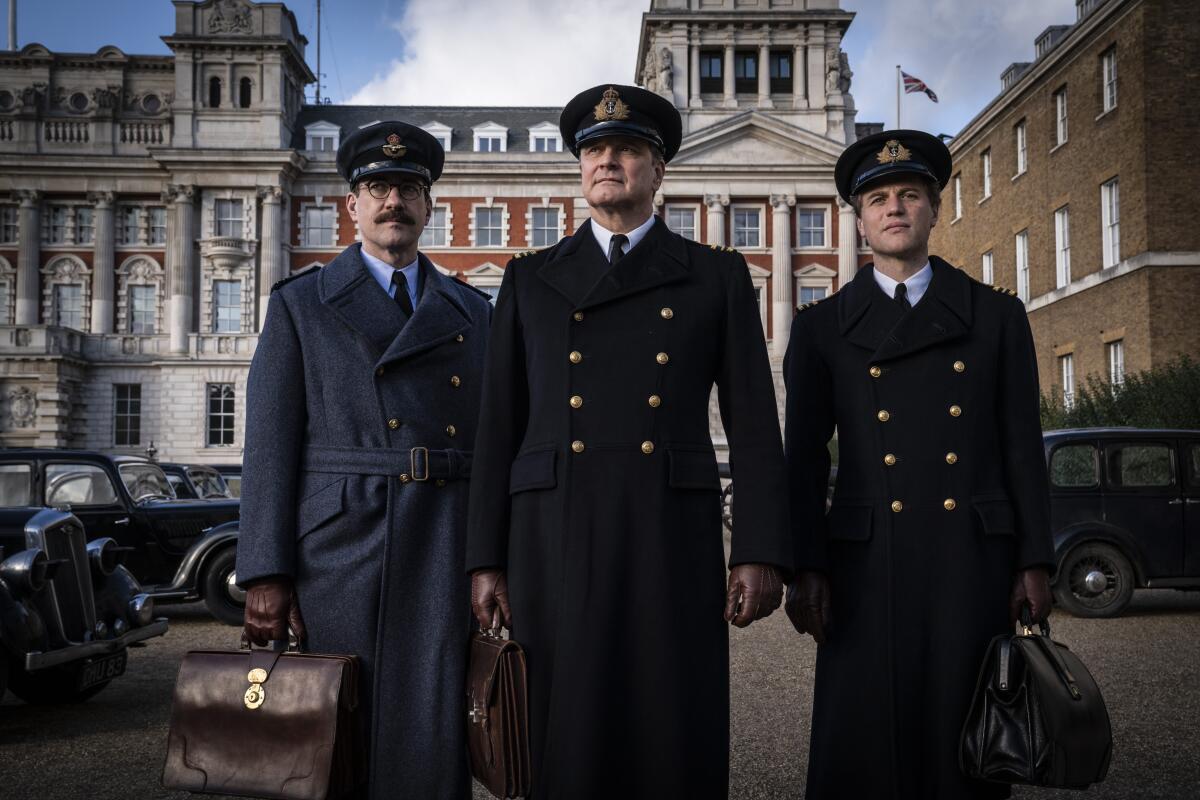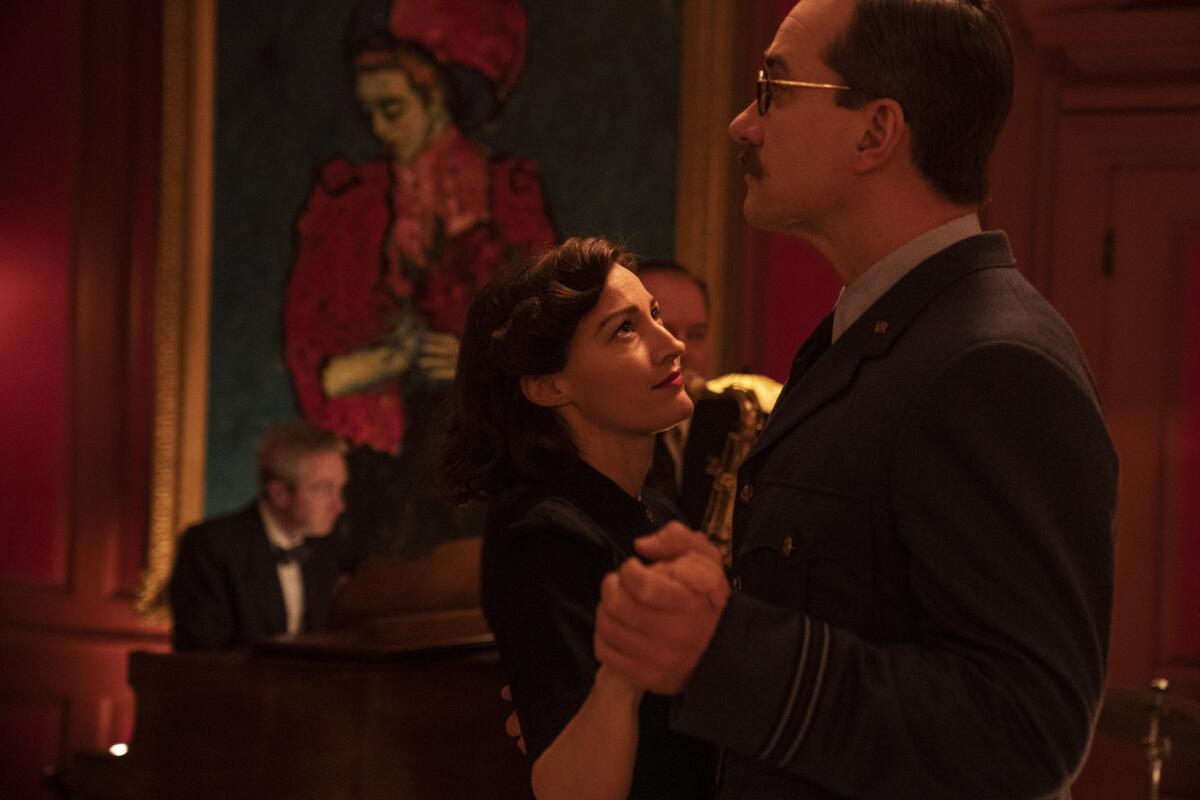‘Operation Mincemeat’ explained: The stolen body and fake intelligence that helped win WWII

London — The Allied victory in World War II hinged on many complex factors, but one of the most unlikely turning points involved the dead body of a Welsh homeless man. In 1943, British intelligence acquired the corpse of Glyndwr Michael from a morgue and dressed him up as a fictitious officer named William Martin, planting fake documents in his clothes to suggest that the Allies planned to invade Greece and Sardinia instead of Sicily.
The idea, a notable example of tactical deception, was to trick Hitler into moving his forces so the Allies could regain control of Europe. It was dubbed Operation Mincemeat — a tongue-in-cheek acknowledgment that they were using a dead body — and this largely unknown spy operation is now the subject of a Netflix film of the same name.
The film, directed by John Madden and written by Michelle Ashford, is based on Ben Macintyre’s expansive 2010 book “Operation Mincemeat: The True Spy Story That Changed the Course of World War II.”
“The story of Operation Mincemeat is true,” explains Macintyre, who was involved in the process of making the film. “Very rarely does spying make much of a difference, but Operation Mincemeat made an enormous difference. And without it — you can’t calculate it — but many, many more lives would have been lost on Sicily’s beaches, including many American lives.”
The 007 connection
The inspiration for the operation dates back to 1939, when British intelligence put together the Trout Memo, a list of 54 possible ideas for how they could fool the enemy. The person responsible for the Trout Memo was none other than James Bond novelist Ian Fleming, then a lieutenant commander. Macintyre says Fleming’s involvement in the operation was “one of the most extraordinary discoveries of this story.”
“Ian Fleming was at that point assistant to the director of Naval Intelligence, Adm. Sir John Godfrey, who would become the model for M in the ‘James Bond’ stories,” Macintyre explains. “One of the things that Fleming did was to draw up, with Godfrey, a memo called the Trout Memo, [which is] now quite famous in intelligence studies.
“One of these ideas, No. 28, was the kernel of this idea, which was to get a dead body and to make it look as if it was an airman who had drowned at sea and equip it with false papers and ship it somewhere. He got the idea from a novel by a man no one ever reads these days called Basil Thomson, who was a pretty dreadful prewar novelist. I love the idea that it comes from a novel and it’s picked up by another novelist.”
It was that meta aspect of the story that most attracted Madden. “They took a fictional idea and tried their very best to make it into an idea that appeared to be absolutely real,” the director adds. “Which then was in danger of being exposed as a fiction and so on. The layers of that. Something immensely attractive about it was this whole thing about writing, about the creation of fiction, and how closely that is allied with espionage.”
Ashford’s screenplay, which was in the works for several years before the film was made, introduces Fleming, played by Johnny Flynn, as the story’s narrator. In a coincidental parallel, Ashford modeled the structure of the screenplay off Madden’s 1998 film “Shakespeare in Love,” taking inspiration from how both stories are about the creation of a fiction that ultimately turns the creators’ lives upside down.

The love triangle
Operation Mincemeat was led by Ewen Montagu (Colin Firth) with the help of Charles Cholmondeley (Matthew Macfadyen). The pair borrowed a photograph — now in England’s National Archives — from MI5 secretary Jean Leslie (Kelly Macdonald) to plant on their fake captain. In the film, Montagu, who was married, becomes involved in an affair with Leslie, which prompts jealousy in Cholmondeley. In reality, it’s uncertain if that affair really happened or whether Cholmondeley had feelings for Leslie.
According to Ashford, it is true that Montagu and Leslie wrote each other a series of letters as fictitious characters and they did sometimes go out. It didn’t feel like a stretch to introduce a love triangle.
“It was a two-hander that I turned into a three-hander,” Ashford explains. “When I ran this up the flagpole, everyone said, ‘That makes sense. That doesn’t feel like a violation of the story.’ Because here’s the thing: We don’t know it didn’t happen. We don’t know that Cholmondeley didn’t have a crush on Jean.”
Macintyre says the affair between Leslie and Montagu has a “decent chance of being true.” The author interviewed Leslie before her death in 2012, but the former secretary refused to acknowledge what had transpired after hours at work.
“She just said, ‘I’m not talking about that anymore. That was a long time ago,’” Macintyre recalls. “In a way that said to me, I think they probably did have an affair, but she doesn’t want to say it. So that element of [the story] has been given a life that we’ll never really know how true it was to life. But that seems, to me, to be perfectly reasonable inside the story like this.”
Adding family ties
Ashford dramatized a few other small elements of “Operation Mincemeat,” including a scene where Glyndwr Michael’s sister is told about his death. The sister character is an invention to help convey that Michael wasn’t simply a prop in a spy mission; he was a real man.
“[It was important] to really try and find in the movie the messiness of war,” Ashford notes. “The fact that they need to do this, but there’s consequences if you just steal a person and stuff them in a life jacket and throw them in the water. I loved that part of the story because I found it complicated and poignant and curious. The sister showing up was a fictionalized element of the story. But he had some family, somewhere. So to make that person appear [is] representative of the fact that that guy came from somewhere.”
The stolen body
While the U.K. government had some freedom to carry out espionage missions behind closed doors, fundamentally Operation Mincemeat was not legal. The intelligence officers colluded with a coroner named Bentley Purchase and took the body from a morgue. After his body was recovered in Spain and the false documents in his pocket made their way into German hands, Michael was buried with military honors as Maj. William Martin.
In Montagu’s 1953 book “The Man Who Never Was” (which was made into a well regarded 1956 movie of the same name with Clifton Webb), the officer claims the government was given permission to use the body and attributes the death to pneumonia. But it wasn’t until 1996 that Michael’s true identity was revealed, and an inscription was added to his tombstone in 1998.
“Basically, they just lifted the body,” Macintyre says. “They believed that nobody would claim it. They believed he had no family. They were wrong about that. They just thought they could get away with stealing the body. It’s as simple as that.”
“The whole thing is macabre and absurd. But one of the reasons the film works so well, I think, is there is a kind of absurd element to it. And that is very true to life. Because the reality is that Montagu and Cholmondeley and the other people involved in this, they were fully aware that there was something ridiculous about what they were doing, which is what gives the film great tension.”
He adds, “It began as a caper. ‘Let’s see if we can hoodwink the enemy.’ But as it went on, they began to realize that they were dealing with incredibly high stakes. If it went wrong, not only were they not going to fool Hitler; they might end up actually sending thousands of people to their deaths.”
For Madden, it was useful to have these emotional, human undercurrents in the film because it might be easy to get bogged down in technical detail. The filmmaker felt that while some of the movie required fictional aspects, everything felt true to the essence of the narrative, as well as to the spy genre itself.
“The story is about speculation,” Madden says. “That’s what an espionage story is about. It’s about guesswork. It’s about hunches. It’s about filling in the gaps. That’s exactly what [the officers] are doing with the fiction they’re creating in the story and hoping that there are no gaps. But, of course, you’re left guessing, even when you’ve covered every single base. The story’s about the creation of a fiction, [and] we were creating our own fiction of this set of events, which themselves are not totally definitive. Because there’s a point where historical research won’t get you any further, and you just have to speculate.”
The historical impact
Looking back, Operation Mincemeat was of monumental importance in shaping the outcome of World War II. While it’s not well known and isn’t typically taught in history classes, the events had a significant impact.
“Europe was just locked down by Hitler and the Germans,” Ashford explains. “[The Allies] were looking at Europe going, ‘How the hell are we going to get in there?’ It was a massive, massive job. And without breaking into Europe and starting to make inroads there, we were going to lose. We were dead. The only way to get in there was to come up through Sicily, and everybody knew it, including the Germans. So how were they going to convince the Germans that’s not what they were doing? So it had made an enormous difference in the war. To say ‘change the course of the war’ is not an overstatement.”
“The idea of planting a false story with the enemy is as old as war — that goes back to the Trojan Horse,” Macintyre adds. “But there’s little doubt that this was the most spectacular military deception ever carried out. It was spectacularly successful. And, of course, it raised the bar thereafter because it meant that all intelligence operations are always looking to see whether they’re being duped.”
More to Read
Only good movies
Get the Indie Focus newsletter, Mark Olsen's weekly guide to the world of cinema.
You may occasionally receive promotional content from the Los Angeles Times.










